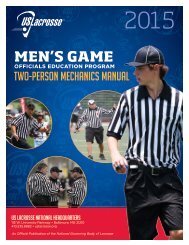BASKETBALL
Create successful ePaper yourself
Turn your PDF publications into a flip-book with our unique Google optimized e-Paper software.
Rule 6 / Live Ball and Dead Ball67<br />
an inbounds player, when a player, who is located on the playing court, touches<br />
and causes the ball to be out of bounds or when the throw-in team commits a<br />
throw-in violation.<br />
Art. 3. The team to be awarded the ball for the alternating-possession throw-in<br />
shall be indicated by the alternating-possession arrow.<br />
Art. 4. The team that does not obtain control of the initial jump ball shall start the<br />
alternating-possession procedure when the next alternating-possession situation<br />
occurs by being awarded the ball at a designated spot nearest to where the held<br />
ball occurred.<br />
Art. 5. After an initial jump ball or a jump ball for the start of an extra period(s)<br />
when possession is not gained by either team, which would establish the<br />
alternating-possession procedure, a jump ball shall take place between any two<br />
players.<br />
Art. 6. Before the start of the second half, the direction of the possession arrow<br />
shall be changed to account for the teams switching ends of the court. The second<br />
half shall start with the team that controlled the alternating-possession arrow at<br />
the end of the first half given disposal of the ball at the division line opposite the<br />
scorer’s table.<br />
Art. 7. The opportunity to make an alternating-possession throw-in shall be lost<br />
when the throw-in team violates the throw-in provisions. (See Rule 9-5.)<br />
Art. 8. A foul by either team during an alternating-possession throw-in shall not<br />
cause the throw-in team to lose the alternating-possession arrow.<br />
Section 4. Alternating-Possession Situations<br />
Art. 1. The ball shall be put in play by the team entitled to the alternatingpossession<br />
throw-in at a designated spot nearest to where:<br />
a. A held ball occurs. (See Rule 6-4.2)<br />
b. The ball goes out of bounds as in Rule 6-4.1.h.<br />
c. A double or simultaneous free-throw violation occurs unless another free<br />
throw or a throw-in is to follow.<br />
d. After a free-throw violation is committed by each team or technical foul<br />
occurs when there is no team control.<br />
e. A live ball lodges between the backboard and the ring or comes to rest on<br />
the flange. (Exception: Rule 9-5.1.c.)<br />
f. The ball becomes dead when neither team is in control and no goal or<br />
infraction or end of a period is involved.<br />
g. An inadvertent whistle occurs, and there is no player or team control.<br />
h. The ball was last touched simultaneously by two opponents, both of whom<br />
are inbounds or out of bounds, or when the officials are in doubt as to who<br />
last touched the ball.<br />
Art. 2. A held ball occurs when an opponent places his hand(s):<br />
a. So firmly on the ball that control cannot be obtained without undue<br />
roughness; or




